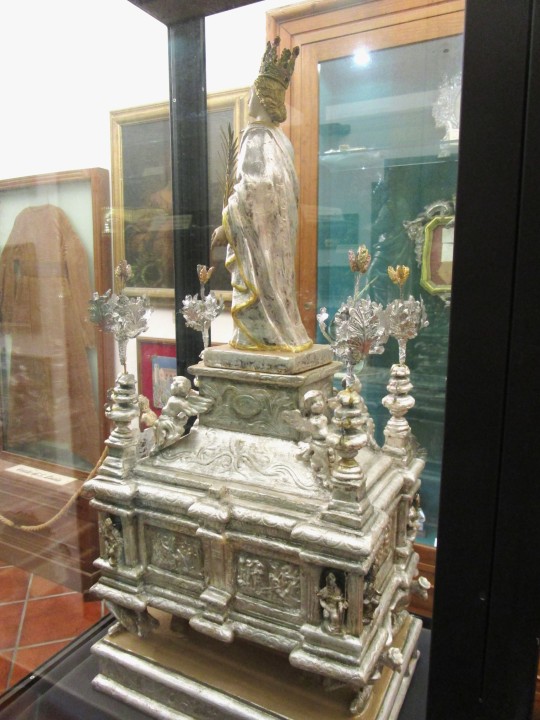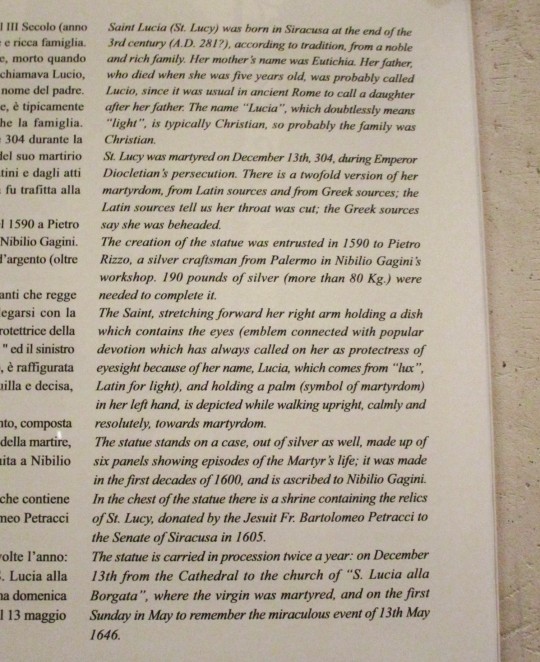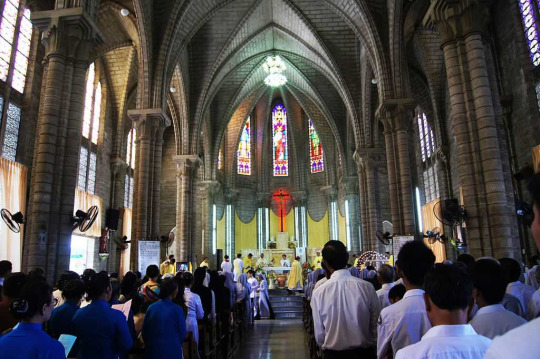#Roman Catholic devotional practices
Photo



Reliquary statue of St. Lucy, 1590, silver, Pietro Rizzo and Nibilio Gagini
Duomo di Siracusa, Sicilia
Photos by Charles Reeza
#Roman Catholic devotional practices#Feast of Santa Lucia#religious procession#silversmith#Syracuse#Sicily#Italy#cult of relics
7 notes
·
View notes
Text

Chrollo tells you a story from his childhood centered around bread.
(Warnings for religious mentions and canon typical depictions of his hometown, Meteor City)

“Hm… how uncanny is that.”
Knowing that he’ll continue speaking cryptic phrases until you express an interest you most certainly don’t have, you sigh, and rest your cheek on your fist.
“What’s uncanny?”
Please don’t mean the bread, please don’t mean the bread, please don’t mean the bread—
“This bread loaf,” he inclines his head toward it, as if you couldn’t spot the table’s lone occupant, “It’s bringing up some memories.”
He’s really going to talk to you about bread. Fuck.
“Meteor City, destitute as it is, was an attractive prospect for missionaries. My friends cared little for the religious doctrine they’d expound, but I always found the teachings fascinating. It wasn’t uncommon to go days without eating, so they’d come along with me on the sole condition that food was being provided. The priest, knowing this, had me relay the message that at his next teaching, there’d be fresh bread. Children overflowed from the tent that normally only I would occupy. He preached his sermon.”
There’s a nostalgic air to him as he continues. “By the end, he presented us with a challenge: whoever capable of best verbally expressing their devotion to God could have the bread. Each child present wanted to be the victor. There was a great deal of murmuring and thinking. He had us form a line, where one by one, we’d give what we hoped to be the winning response. My friend Phinks was first. ‘If I’d been there, I’da stomped the shit out of that snake,’ is what he went with. As you can imagine, the priest kept going down the line.
Eventually, he got to me. I’d been closely monitoring his body language and facial expressions. From what I could tell, no answer so far had even come close. I decided to take a different approach. From his theology, I could tell he was of the Roman Catholic persuasion. And so I suggested that to best prove our love, we should have mass. I thought that by focusing on the collective rather than oneself, I’d meet his unspoken criteria. He intended to keep the results to himself until everyone had spoken their piece, but no sooner as the words left my mouth did I know that wasn’t the answer he was looking for.
After everyone had their turn, he brought the bread out for all to see. While we were all excitedly wondering who the lucky individual would be, he raised his voice and began admonishing us. He quoted Matthew, ‘It is written: Man must not live on bread alone, but on every word that comes from the mouth of God’. With that, he left us there, so that we could ‘think about what we’ve learned’.”
Your jaw practically hits the floor.
“I intended to counter his points later that night to see if I could win the community the bread they were promised. While I was preparing, a few children happened by, eating the bread that was pulled from under our noses. I asked where they got it from — they said Uvogin. Apparently, he learned what had happened and was incensed. I went to go see him so I could ask how he convinced the priest to give him the bread. I didn’t find Uvo at the place he normally hung out at, but I did see the priest.
He was… shall we say, arranged in a way that’s strenuous on the body. All the while he kept chanting, ‘Pater, aphes autois, ou gar oidasin ti poiousin’, though he lay dying. It left a strong impression on me. Especially because his pronunciation was slightly off… but more than that, I thought it interesting he held firm to the belief which landed him in this position. A belief he didn’t even understand properly. He passed with a content expression. He must’ve fancied himself a martyr. It later became a popular joke that in the end, he did prove that you can’t live on bread alone, since it didn’t seem to do him much good.”
“How… how old were you?”
“Seven or eight, I believe.”
You get up from the table. You can feel his eyes following your every movement, from the suite’s dining room to the living space it's connected to. The suitcase you’ve yet to unpack sits patiently as you rummage through its contents. Grabbing what you need, you return to the table, where Chrollo regards you with a curious countenance.
Your antidepressants rattle inside a small orange container as you put it before him. How he gets the medication, you haven’t the slightest clue. It’s more convenient to receive them from your enigmatic kidnapper than an uninsured trip to the psychiatrist. He’s got one thing going in his favor, at least.
“Do you already need a refill?”
You shake your head.
“Just… after hearing that story… I think you might want to consider getting some of these for yourself. High dose.”
491 notes
·
View notes
Text

btw, if you ever wanted a really quick glimpse of how the Dewey Decimal System is biased in favor of white Christian Europeans, just check out the 200s section:
200 Religion 201 Philosophy of Christianity 202 Miscellany of Christianity 203 Dictionaries of Christianity 204 Special topics 205 Serial publications of Christianity 206 Organizations of Christianity 207 Education, research in Christianity 208 Kinds of persons in Christianity 209 History & geography of Christianity 210 Natural theology 211 Concepts of God 212 Existence, attributes of God 213 Creation 214 Theodicy 215 Science & religion 216 Good & evil 217 Not assigned or no longer used 218 Humankind 219 Not assigned or no longer used 220 Bible 221 Old Testament 222 Historical books of Old Testament 223 Poetic books of Old Testament 224 Prophetic books of Old Testament 225 New Testament 226 Gospels & Acts 227 Epistles 228 Revelation (Apocalypse) 229 Apocrypha & pseudepigrapha 230 Christian theology 231 God 232 Jesus Christ & his family 233 Humankind 234 Salvation (Soteriology) & grace 235 Spiritual beings 236 Eschatology 237 Not assigned or no longer used 238 Creeds & catechisms 239 Apologetics & polemics 240 Christian moral & devotional theology 241 Moral theology 242 Devotional literature 243 Evangelistic writings for individuals 244 Not assigned or no longer used 245 Texts of hymns 246 Use of art in Christianity 247 Church furnishings & articles 248 Christian experience, practice, life 249 Christian observances in family life 250 Christian orders & local church 251 Preaching (Homiletics) 252 Texts of sermons 253 Pastoral office (Pastoral theology) 254 Parish government & administration 255 Religious congregations & orders 256 Not assigned or no longer used 257 Not assigned or no longer used 258 Not assigned or no longer used 259 Activities of the local church 260 Christian social theology 261 Social theology 262 Ecclesiology 263 Times, places of religious observance 264 Public worship 265 Sacraments, other rites & acts 266 Missions 267 Associations for religious work 268 Religious education 269 Spiritual renewal 270 Christian church history 271 Religious orders in church history 272 Persecutions in church history 273 Heresies in church history 274 Christian church in Europe 275 Christian church in Asia 276 Christian church in Africa 277 Christian church in North America 278 Christian church in South America 279 Christian church in other areas 280 Christian denominations & sects 281 Early church & Eastern churches 282 Roman Catholic Church 283 Anglican churches 284 Protestants of Continental origin 285 Presbyterian, Reformed, Congregational 286 Baptist, Disciples of Christ, Adventist 287 Methodist & related churches 288 Not assigned or no longer used 289 Other denominations & sects 290 Other & comparative religions 291 Comparative religion 292 Classical (Greek & Roman) religion 293 Germanic religion 294 Religions of Indic origin 295 Zoroastrianism (Mazdaism, Parseeism) 296 Judaism 297 Islam & religions originating in it 298 Not assigned or no longer used 299 Other religions
(found here)
"Christian/Christianity": 25—with many other words and phrases, like "Anglican churches," "Protestants," "Baptist," and "Old Testament," also indicating Christian topics
Judaism: 1
Islam: 1
Most other world religions, clumped together: 1
71 notes
·
View notes
Note
Would absolutely LOVE to know about your beliefs and practices. I live in a very toxic Christian house but I've always been drawn to these kinds of things.
I was raised catholic and while my fascination with certain catholic symbols and rituals has stayed with me I decided it wasn’t for me when I was about fourteen. I got into witchcraft first, though I now mostly focus on deity work. At first I attempted to work with some hellenic gods but while it was fascinating and I learned a lot, I craved something different. I don’t even quite remember how I stumbled upon Luciferianism but I felt instantly drawn to it.
In my belief I view Satan and Lucifer as two distinctly separate beings and while I currently only work with Lucifer I intend to look into satanism as well. While I am a theistic luciferian, meaning I believe in him as an actual entity, I do see him more as a symbol, or rather, personification or certain traits, like knowledge, pride, etc. This is also why it’s difficult to state what kind of being he is exactly. Some view him as a demon, some equate him with Satan and use the two names interchangeably, there is also a minor Roman god called lucifer and some atheistic luciferians just follow the things he represents, much in the same way that atheistic satanists do. I’ve given up attempting to categorise my belief or try to fit into one specific belief system. To me, lucifer is everything. He is with me every step of the way and I love him so much.
As for my practices, as I said I used to do lots of spell work and things like that, now I mostly focus on offerings, prayer, divination, anything to connect me to my deity. I also intend to create and celebrate some of my own holidays in the future, since there aren’t a lot of “official” sacred luciferian days out there.
Due to reasons I don’t really want to bring up, my practice is very casual, I’m often unable to do big rituals or offerings so I incorporate lucifer into my daily life so I can worship and honour him even if I don’t have a lot of energy. I do this by doing things like wearing his sigil every day, wearing devotional oils, lighting candles, praying to him, offering him parts of my meals or drinks or just inviting him to sit with me.
That was probably a lot more information than you wanted but I’ll take every opportunity I can to talk about Lord Lucifer so thanks for the ask :D
#luciferianism#lucifer#luciferian#witchcraft#theistic luciferianism#deity work#lucifer deity#lucifer devotee#theistic satanism#satanism
46 notes
·
View notes
Text

Religion in Vietnam
Despite Vietnam being on atheist state officially, religion is an integral part of Vietnamese culture and everyday life. While Buddhism, Catholicism and Protestantism find followers in the country, the dominant religion is the Vietnamese folk religion. This religion combines elements of Confucianism, Taoism and Buddhism along with indigenous practices.
Vietnamese Folk Religion

Cao Daism, a monotheistic Vietnamese folk religion fusing
aspects of Confucianism, Taosim, and Buddhism
A major component of Vietnamese folk religion is the Than (spirit or deity) which may be nature gods, community deities or ancestral gods of a particular family. Ancestral veneration is especially prevalent, and narratives of heroic acts and cosmic forces abound in local mythology. The temples, known as Mieu are usually located away from the city's bustle in more secluded areas. Mother Goddesses also form an important part of the theological aspect of Vietnamese culture; The Lady of the Realm and the Trung sisters have multiple shrines across the country.
Buddhism in Vietnam

The Long Son Pagoda in Nha Trang, a Buddhist Temple with a
large white marble Buddha statue seen behind it
Buddhism arrived in Vietnam through India and China as early as the second century AD. Vietnamese Buddhism is significantly different from the way it is practised elsewhere, as is evident by the absence of sanghas, hierarchy and other institutional structures that usually exist. Mahayana Buddhism is the dominant school of Buddhism here, coupled with elements of Taoism and Chinese beliefs. Practitioners focus less on spirituality and more on devotional rituals such as chanting sutras and dharanis to obtain the blessing of Bodhisattvas.
Christianity

Mass in progress at the Christ Church, Nha Trang
The most widespread church in Vietnam is the Roman Catholic church, which arrived with the Portuguese missionaries and strengthened its foothold with the French colonialists. The national language script of Vietnam used in present times, written in the Latin alphabet with diacritics, also came into use with the help of these missionaries. Protestantism also gained following over the last century, and now has over 50,000 practitioners.
15 notes
·
View notes
Text



Vatican Cityyyyyy!!!!!!!!!! 🇻🇦he’s real and he’s old :)
Vatican City State // Stato della Città del Vaticano // Status Civitatis Vaticanæ
Giovanni D’Amico • he/him • February 11, 1929 • 1,642 years old (71 human years)
Originally born around 380 AD when Christianity was made the empire’s official religion by Emperor Theodosius. Would later, in 754 AD by the Donation of Pepin, be known as the Papal States until year 1870. Finally, in 1929, he would be known as Vatican City.
Vatican City is a multifaceted elderly man. A loving and strict father, one who prefers tough love over a soft and gentle touch— he’s honest about the world and it’s struggles, even to children, and doesn’t sugar coat it when someone needs to be straightened out/intervened. He’s a devoted catholic who was ordained in 1961; if you ask him why he didn’t become a priest earlier, he’ll avoid answering, starting a brand new conversation all together or just walking away without a word. He has his reasons. Don’t underestimate him, however, because of his charming smile and kind air, he can be pretty cunning and even manipulative when he wants to be. His father was the Roman Empire after all.
Vatican City gets along with most people he meets and is pretty optimistic most of the time, much like Veneziano is. But he can lose his temper, or be in frequent bad moods, over small inconveniences in similar ways to Romano. Unlike the boys, he has a very close personal relationship with Switzerland— meaning he can walk onto his property uninvited without being shot at or chased out. This is due to their history since 1506, when Pope Julius II asked the Swiss to provide protection during the Italian Wars.
His relationship with the boys are actually newly built. Before now, his longest and closest interaction with the boys was when they were children. So having more time with them now is a little out of place to Vatican City when last he saw them was when they were teenagers and now they’re fully grown adults. It is still a little difficult to remember that oh yeah Veneziano is no longer a toddler, I shouldn’t be babying him like this. Romano isn’t some kid anymore either, he’s old enough to make his own decisions now. They’re still his kids though so of course he’ll baby them sometimes. His relationship with Seborga is the same as the Italies’— although the boys have noticed he treats Seborga with a softer hand than he did when they were kids. Like Rome often did, he shows favoritism. And Seborga is “allegedly” his favorite.
He walks with a limp, which many are unsure how it was obtained, some assuming it’s France’s fault when he lived in Avignon and jokingly shun him for kicking such a “harmless kind soul”. The real reason he limps is because of a humiliating trip he took down a flight of stairs in 1312, a story he plans to take to the grave. Vatican City uses a sleek wooden cane, however it’s more for the aesthetics than for practical use.
Vatican City claims to be extremely humble and honest, but he does pride himself on his continuous unwavering faith. He doesn’t brag about it though. …..Not often. He’s always looking out to help those around him, however he isn’t actually that good of a listener so sometimes he can totally misread the situation and apply the wrong fix/advice. He’s got a bigger mouth than he does ears.
Hobbies:
Reading
Just barely keeping the house plants alive Gardening
Cooking
Notes :)))))
I made him old as a contrast to the Italies— wanted him to stand out and seem wiser than them without actually being wiser because let’s face it. None of these fuckers are very smart. I can’t decide specifically when he ages so rapidly like this, but I am leaning towards the mid 1700s. He does appear much older than Rome, who, when he fell, was roughly 55-65 human years in appearance(in my headcanon). Also, if I remember correctly, Hima did describe how he thinks Vatican City would look— old and grouchy— which I didn’t remember until like. After I finalized this design 2 years ago 💀 which is awesome! We need more grouchy old men nations! Wrinkles are hot too! /j? even with the grouchiness, I really wanted him to be more like Veneziano, so I kind of split it in half, VC sharing traits with both the Italies.
Final side note that I couldn’t make fit above— yeeeeeah he’s kind of homophobic but at least he’s the type to not voice his disapproval so loudly or tries to force his opinions on others. He kind of just awkwardly and uncomfortably leaves the situation or starts a new conversation if you bring up being queer. Its the topic he’ll avoid, not the person. He’s not transphobic tho, even if he does misuse pronouns sometimes. Well he doesn’t understand nonbinary or genderfluid identities. He’s….. he’s trying at least. I think he actually forgets Romano is a transman though— “My daughter? I have two sons- oooooh yeah. That- no I have two sons now.” Also he’s celibate. Has been for many many years, even before he was ordained.
Please correct me if I got any historical or otherwise facts wrong!
#hetalia#hetalia fanart#hetalia oc#hws vatican city#oc: vatican city#hws veneziano#hws north italy#hws san marino#oc: san marino#hws romano#hws south italy#hws seborga#hws switzerland
45 notes
·
View notes
Text
I present to you The Venerable John Boswell, who should be remembered by every church and every Christian who considers themselves “open and affirming.”

If you have heard of John Boswell, you've probably heard of his name in conjunction with words like "controversial" or "disputed." This is an absolute shame, because I've been getting to know him and his work over the last couple of months for a different project, and I've come to think of him as "my dead friend." According to an (alive) friend in religious studies, "a saint is just a dead friend who can pray for you," so I am presenting him in the form of a traditional icon.
Iconography:
"The Venerable": in one sense bitterly ironic, since Professor Boswell died young. On the other hand it calls back to the Venerable Bede, also a historian whose work has been "challenged."
Tongue of flame: a traditional symbol for the Holy Spirit. One of the traditional gifts of the Holy Spirit is the gift of "speaking in tongues" and the "interpretation of tongues." Professor Boswell spoke or read at least 17 modern and classical languages.
Harvard Doctoral robes: a symbol of his academic achievement and authority. Professor Boswell was educated and worked in some of the most prestigious institutions in the world, and was briefly the chair of the Yale history department before he had to step down because of his illness. Someone like Thomas Aquinas probably would have considered him a social equal. He was not "a single controversial historian" with a couple of crackpot theories.
Palm frond: a traditional symbol for martyrs. In a very broad sense, a martyr is someone whose death can teach us something, or is otherwise "theologically significant." Professor Boswell died of AIDS in 1994. HIV/AIDS is not "God's judgment upon sinners," as some conservative fanatics believe. It is a mindless disease that governments and other institutions (including churches) allowed to spread unchecked in gay communities for years, simply because they were gay. It was only when "respectable" people began coming down with it that medical research began in earnest and public health protocols were put into practice. It was, and still is in some places, a public health disaster even now that effective treatments for it exist. Professor Boswell was one of the vanguard of AIDS patients who died before effective treatments were available, and part of a generation of queer elders who should still be with us. He would be 76 years old in 2023.
"The crown of glory for me is with you": this is a line from "The Passion of SS. Serge and Bacchus," which Professor Boswell translated into English for the first time, which makes it widely available to people outside of small, elite academic circles. In the legend, Bacchus has been martyred and has appeared to Sergius in a vision. He uses this line to encourage Sergius to stay strong until they can be reunited in heaven. In another sense, the icon of Professor Boswell is encouraging the people who admire him to keep up his work. Keep digging up subversive, queer Christian history, and keep challenging him. We didn't stop writing English history after the Venerable Bede, and we won't stop writing LGBTQ Christian history after the Venerable Boswell.
Hagiography:
Professor Boswell, known as Jeb to his friends and family, was said to be remarkably kind, generous, funny, and sensitive. He was beloved by his students and respected by his colleagues. He became a devoted Roman Catholic when he was a teenager, and attended Mass daily. He was approachable and open regarding the challenges of being both gay and Christian, and was also openly critical of the Church in spite of (or perhaps because of) his personal faith. He challenged both religious conservatives, for obvious reasons, and also "enlightened secularists" whose dogma held that "organized religion," and Christianity in particular, was the root cause of all homophobic discrimination in the world. There are many people who would have preferred to let his life and work quietly slip into the past, and there are even some who have actively tried to erase him, but John Boswell will not be erased. In my opinion, Professor Boswell should be officially commemorated by every church that considers itself "Open And Affirming." This modern movement builds on work done by Professor Boswell, and he must be respected in all of his twinky, flamboyant, brilliant, and life-giving glory. He declared that queer people could know God without shame or self-censorship, and that the Church could be made to repent and welcome us as it once did.
Further Reading:
If you have a couple of hours, I recommend the single known video recording of one of his lectures: Jews, Gay People, and Bicycle Riders (1986). This is an excellent introduction to his work.
https://www.christiancentury.org/article/first-person/john-boswell-s-faith-lit-generation
https://qspirit.net/john-boswell-historian-gays-lesbians/
https://www.findagrave.com/memorial/17004797/john-eastburn-boswell
https://www.wm.edu/as/dean/boswell/about/index.php
https://lgbtqreligiousarchives.org/profiles/john-boswell
https://sourcebooks.fordham.edu/pwh/index-bos.asp
https://archives.yale.edu/repositories/12/resources/5188
38 notes
·
View notes
Text
I dont have enough space in my room for a single altar to Santa Muerte.
So what I decided to do? Put my side cabinet (which has been Her altar for the better part of 3 years) next to my big altar.
I'm a english-Folk Magic practitioner (i do the "magic" of the "cunning folk". I practice the old ways i guess? I don't see it as "magic", i just see it as a fact of life?) i grew up Catholic, taught Buddhism, got into Norse Paganism, Greek Paganism (Hellenism)/Greco-Roman. Got into (P)IE gods.
Im a mix. A whole mix. Like someone picked up a "religion" book n i absorbed every religion!
But Santa Muerte and Mary are just... different. They just are.
They're like sisters to me, which is why i have my altar part to The Goddess (/Mary) next to Holy Death's altar.
She is life- She is Death.
She is the be all and end all, She is everything.
And my Lady Holy Death, my Rose, deserves a whole massive altar just to Her but i cant give Her it!
So for the time being im heavily decorating Her altar (it's separate and not actually conjoined with my big altar)
I love Santa Muerte, my Rose ❤️. Im very devoted to Her. I love Her, i respect Her....She is Death.
She's not like Hades, who rules over the dead- no She Is Death.
This is how I view Her, but yes She has Her own altar, just next to my usual one.i even have skull lights to act as a "Barrier".
I dont honestly think She has a problem with sharing a space/altar- but its my own personal thing. Her... vibe? Energy? Is so strong, i dont like it mixing in with my usual prayers to Our Lady Mary.
I have autism + adhd so i jump a lot in terms of what i pray to on a specific day. But My Rose has always comforted me, regardless of if im praying to Her that day! :)
#i have many different ideas on Gods and how they exist#but Our Lady and Our Lady Holy Death have saved me MANY times. ❤️❤️#saint death#lady death#santa muerte#la santa muerte#our lady#english folk magic#english folk#english folklore#hellenic paganism#religions#ecelectic witch
11 notes
·
View notes
Text
okie doke: long-story short, im really wanting to get my spiritual life in order. it feels like ive kinda been in a rut and i would love to switch it up.
i am thoroughly Roman Catholic, but have a strong affinity for the Eastern/Byzantine spirituality. any devotions/prayers/practices you all on cathblr would recommend? feel free to reblog as you see fit.
tyia and praying for you!
#catholic#cathblr#catholic tumblr#do your thing#orthodox#Byzantine#prayer request#memento mori#christianity
4 notes
·
View notes
Text
“So impressive has Catholic charitable work been that even the Church's own enemies have grudgingly acknowledged it. The pagan writer Lucian (130-200) observed in astonishment, “The earnestness with which the people of this religion help one another in their needs is incredible. They spare themselves nothing for this end. Their first lawgiver put it into their heads that they were all brethren!'" Julian the Apostate, the Roman emperor who made a futile, if energetic, attempt in the 360s to return the empire to its earlier paganism, conceded that the Christians outshone the pagans in their devotion to charitable work. "Whilst the pagan priests neglect the poor," he wrote, "the hated Galileans [that is, the Christians] devote themselves to works of charity, and by a display of false compassion have established and given effect to their pernicious errors. See their love-feasts, and their tables spread for the indigent. Such practice is common among them, and causes a contempt for our gods.' Martin Luther, as inveterate an enemy of the Catholic Church as ever lived, was forced to admit: “Under the papacy the people were at least charitable, and force was not required to obtain alms. Today, under the reign of the Gospel [by which he meant Protestantism], in place of giving they rob each other, and it might be said that no one thinks he has anything till he gets possession of the property of his neighbor."
- Thomas E. Woods Jr., Ph.D., “How Catholic Charity Changed the World,” How the Catholic Church Built Western Civilization
8 notes
·
View notes
Photo


Macchina della Quarantore - Forty Hours Machines were elaborate constructions created during the Baroque age to provide a magnificent setting for the Roman Catholic devotional practice of forty continuous hours of prayer and “adoration” of the “Blessed Sacrament” - a consecrated Eucharistic host in which the body, blood, soul, and divinity of Jesus Christ is believed to be substantially present. An elaborate display vessel called a monstrance would be placed in the niche where the statue with the raised arms is in these photos. The candlesticks and other decorative objects are all part of the movable display that could be set up wherever it was needed. The large circle of golden rays at the back is known as a “glory.”
This forty-hours machine was created in 1676 for San Domenico Maggiore church in Naples, Italy - Photos by Charles Reeza
#Roman Catholic#devotional practice#eucharistic adoration#prayer#liturgy#Baroque art#Napoli#Italia#travel photos
29 notes
·
View notes
Text
Bill Schnoebelen, a man who claimed to be an ex-satanist (of the global satanic conspiracy sort) and has been demonstrated time and again to be a fraud, tries to establish a link between witchcraft (of the modern neopagan sort) and Roman Catholicism in Wicca: Satan's Little White Lie:
Both teach “salvation” through ritual acts and good works.
Both have a god and a goddess (Mary) figure in their pantheon.
Both have a slain and risen god who dies and is reborn in a seasonal cycle of ritual dramas.
Both have magic or thaumaturgy (Transubstantiation in the Mass) as central elements in their theology.
Both make extensive use of incense, statues, candles and ceremonial robes in their devotions.
Both believe in a kind of second chance after death (Purgatory).4
Both believe the rituals of the living can affect the dead.
Both believe in rituals of pain and mortification for purification.5
I'm sorry, Bill, but if you think that three and four are actual problems, then you might as well just give up on Christianity altogether, or at least admit that your version of Christianity regards a good portion of the New Testament as heretical. Because you've literally just declared that both Communion and the Resurrection are unchristian.
Also, if the idea of transubstantiation makes you uncomfy, 1 Corinthians 15:35-55 should have you crawling out of your skin.
Regarding number two, Mary is revered because she's a saint and the mother of Jesus. That doesn't make her a "goddess," because Catholicism has clear distinctions between saints and deities.
Regarding number five, this is because Catholic religion makes use of worship traditions that were widespread throughout the ancient Mediterranean world. Modern neopaganism drew from these same traditions. There's nothing sinister or conspiratorial about it.
Regarding number six, Schnoebelen elaborates on this one in the footnotes:
Catholics offer prayers for the dead, to get them out of Purgatory. Witches believe in communicating with the dead, especially at Samhain; and that they can, through mediumship, help lower level spirits achieve higher areas of growth before they incarnate again.
Loads of people believe you can interact with or affect the dead in some way. This doesn't prove any special connection between modern witchcraft and Catholicism.
He elaborates on number eight with:
Although this self-mortification element has been toned down recently in U.S. Catholicism, wearing of hair shirts, barbed wire corsets and self-flagellation (whipping) were regularly practiced within Catholic monasteries and nunneries until at least the 1960’s. It may still be going on today in the U.S. and is definitely still practiced overseas. Witches believe you must be willing to “suffer in order to learn” and most practice at least ceremonial whipping of each other. Wiccan authors also brag about how they whipped each other into a magical frenzy in order to raise a large enough “cone of power” to turn back both the Spanish Armada and the forces of Hitler.
Bill. Bill, my man. You might be shocked to learn that the New Testament has a lot to say about the value of suffering. Romans 5:3-4, 2 Corinthians 1:5, Philippians 1:29 2 Corinthians 11 and 2 Corinthians 12 - Paul was kinda big on this whole suffering thing, ya know?
So basically, Schnoebelen's made up a bunch of problems where none exist, and in doing so, implied that the very religion he professes to follow is actually invalid, lol.
31 notes
·
View notes
Text
Communing with The Gods: Intuition & Interpretation (TW: Trauma)
"Why are you continuing your attempt to find spiritual comfort in women, when that is a wound you are still healing from? Why, in leaving Hindu spirituality, are you making the same choices in Hellenism and expecting a different result? If Hestia cares for you, She is not going to perpetuate this cycle - if Hestia cares for you, She is not going to allow you to continue down this path."
Recently I have been attempting to incorporate more Hellenic Paganism into my everyday life, and part of this has been in offering acts of devotion. A couple of weeks ago I made the decision to start offering various household chores as devotional acts to Hestia.
In my teen years, I worked with Hestia informally; so when I began to delve into Hellenic Paganism I thought Hestia would be a good entity to establish a formal relationship with.
So, a week ago - before beginning the chores I had for the day - I would light a candle, invoke Hestia in the traditional style, and present for Her the act/s as a devotional offering.
I did this for 3 or so days, but each time I did - I felt an emptiness. Instead of feeling like there was any additional energy with me during my invocation or while doing my chores, I felt entirely alone.
When working with deities in the past (say Apollo or the Hindu Goddess Shailputri) I would usually feel some kind of energy with me during my work. This energy could be subtle, like a warmth or joy, or overt like the feeling of an entity sharing space with me.
When these feelings didn't occur - to me, it felt like Hestia was ingoing me; I felt like I had knocked on Her door and She had opened it a crack only to shut it in my face.
This really upset me; I felt extremely rejected and didn't understand why Hestia seemed to want nothing to do with me.
And then, last Sunday, it finally all clicked.
[Additional Context: When I first began my Hellenic Pagan practice, I decided that (in addition to Hestia) I wanted to work with Apollo. This was the first "male" or "masculine" entity I have worked with in almost the entire tenure of my time being a Witch and a Pagan (which now spans over 10 years).
I come from a Roman Catholic background, and due to religious trauma I am very hesitant and wary of male entities and male deities specifically.
However, as a musician, artist, and queer man - I feel a great affinity for Apollo and the areas of life He presides over.]
So back to Hestia. What I thought was rejection from Hestia was actually Her, in Her own way, sending me a message that I initially was too upset to hear.
(I'll explain how I came to this conclusion in a second) but what I realized was, that Hestia was trying to say to me was:
"You need to work with Apollo and take a break from working with female deities. You're in pain and you can't heal if you continue to rely on the cause of your wounds (mother figures). I am not rejecting you, I am trying to show you that now is not the time for you to work with Me."
This realization, I'll be honest, felt like a punch to the gut (in a good way). It felt so affirming and awe inspiring to realize that I was being answered - and that what I needed to do was actually listen for what was being said instead of what I wanted to hear.
How I Came to This Conclusion:
Given what I had already experienced in the past with Shailputri and Apollo, what I was experiencing with Hestia elicited confusion - and also made me doubt my past experiences. So, I decided to think critically about the situation.
I first examined if maybe it was what I was offering was the problem - maybe Hestia didn't like me offering the act of doing the dishes since that act is so heavily associated with water? Okay, if that was the case, why would She reject all of the other offerings that had no significant ties to the elements? I came to the conclusion that what I was offering wasn't the issue - so I continued to reflect on the experience.
A day or so later I was having a conversation with my partner (in the kitchen) after therapy, discussing a variety of topics, but the one that stood out was my discussion of the trauma I have/had experienced at the hands of women over the past 3+ years. It was during that discussion I felt what I can only describe as a mental tap on the shoulder.
I didn't hear any voices in my head or see any physical signs, but mentally I felt like several different puzzle pieces I had been trying to lay flat fit into place.
"Why are you continuing your attempt to find spiritual comfort in women, when that is a wound you are still healing from? Why, in leaving Hindu spirituality, are you making the same choices in Hellenism and expecting a different result? If Hestia cares for you, She is not going to perpetuate this cycle - if Hestia cares for you, She is not going to allow you to continue down this path"
Since beginning this journey into Hellenic Paganism, I have found myself in awe of The Gods - how They communicate with me - and how brutally honest They are. A lot of people like to give The Gods the "✧・゚: *✧・゚:* 0w0 ✧・゚: *✧・゚:*" treatment, but (in my experience) The Gods are so much more complex than we give Them credit for. And They can be a lot more blunt than you might assume.
---
Praise be to Hestia, Goddess of the Hearth, Goddess of the Home - You have guided me towards a better path and for that I thank You.
Praise be to Apollo, God of Music, God of Art - I aspire to demonstrate my devotion and admiration for You, and continue on this journey of building Kharis with you.
Do Ut Des
#religion for sale#religion-for-sale#pagan#paganblr#hellenic pagan#hellenic polytheism#apollo#lord apollo#hestia#lady hestia#deity work#deity communication#deity rejection
17 notes
·
View notes
Text
Introduction
⋅───⊱༺ ♰ ༻⊰───⋅
hello, peace be with you, and welcome to my blog!
⋅───⊱༺ ♰ ༻⊰───⋅
About this page:
This blog is mainly intended to be used to compile resources & information i’d like to curate and incorporate into my day-to-day spiritual life, as i’m trying to bridge an odd gap in both my mental health and my relationship with God. you’re more than welcome to stick around if you find my reposts & such helpful :)
my username is a reference to Isaiah 53:5, “by His scourging, we are healed.” the blog title is the English translation of my paternal family’s motto: “Elatum a Deo Non Deprimat”
the word “witch” is in quotations marks within my bio simply because although “witchcraft” is probably the closest word to describe what it is i’m practicing, the title of “witch” feels like something i have outgrown and is no longer accurate to my spiritual practices and such. no judgement intended toward anyone who does refer to themselves that way!
─── ⋆⋅ ♰ ⋅⋆ ───
Here’s some very basic information about me:
my name is Francis, though you may call me Frankie if you’d like!
i am 22 years old — an October baby!
i am a baptized and confirmed Roman Catholic
i have attended Catholic school for all levels of education i have received thus far
i am a student of theology with a concentration in interfaith studies at a Jesuit university (and am also aiming for a minor in peace & justice studies)
a non-negligible part of my personal theology/relationship with God has been influenced by Buddhist thought, particularly in regards to theology of the body
i have an 18 month old kitten named Assisi (nicknamed Sisi!) who followed me home on the feast day of Saint Francis <3
─── ⋆⋅ ♰ ⋅⋆ ───
My interests related to this blog include:
folk Christianity (especially) Catholicism, including: Irish/Celtic folk Catholicism; Appalachian (especially southwest PA/north WV) folk Christianity (Catholic and/or Protestant); Slavic folk Christianity; German folk Catholicism; and Britannic folk Christianity
folk witchcraft/magic related to the aforementioned practices
Braucherei
how to be more Christlike
the Five Wounds of Jesus and the Sacred Heart
Marian Devotion (my relationship with our Virgin Mother has never been the strongest, which I’d like to change)
saints and practices involving working with saints, especially but not limited to: St. Joan of Arc, St. Dymphna, St. Francis of Assisi, St. Anthony, St. Expiditus, St. Joseph and St. Paul of the Cross
angels, guardian angels, and archangels, as well as practices involving working with all three
bibliomancy (specifically with the Bible) or other Christian-oriented/inspired divination
trans theology
cats and Christianity
witchcraft regarding familiars, chiefly cats
spoonie witchcraft
urban witchcraft
⋅───⊱༺ ♰ ༻⊰───⋅
GODBWYE!
⋅───⊱༺ ♰ ༻⊰───⋅
#catholic witch#appalachian folk#irish folk catholicism#irish folk#german folk catholicism#german folk#bibliomancy#christian witch#spoonie magic#spoonie witch#urban magic#saint magic#american folk magic#christian magic#familiars#witchcraft#angels#archangels
3 notes
·
View notes
Note
I have a special question. If I am not a catholic, I am orthodox christian. Does it mean that I need to be a catholic to practice vodou? I respect the Pope and sometimes go to the catholic mass or pray rosary, but I was baptised in Orthodox church. What do you think about it? And one more question. I heard that after Revolution in Haiti one of the Pope recognised vodou as a form of catholicity. If you need I can find a name of this Pope.
Hi there,
No one needs to be Catholic to practice Haitian Vodou, but folks need to be comfy with Catholic practices and become fluent in them. Haitian Vodou is a blended religion (versus syncretic...nothing is hiding) that has made a seamless root out of things that seem disparate: African spiritual practices, Roman Catholicism, Indigenous practices, and even some Islamic influences.
Things that look Catholic are heavily present: saints and saint images, a lot of prayers, cultural practices and devotions, and participation in some Catholic rites. It's something folks learn and become comfortable navigating over time but doesn't mean anyone needs to be Catholic to practice, though many Vodouizan are Catholic regardless.
John Paul II recognized Vodou as a significant cultural practice when he went to Benin and specifically said that being Christian would not betray the faith of practitioners. Pretty significant from the guy who is supposed to be more Catholic than everyone else. Hasn't stopped the Catholic church from evangelizing heavily in Haiti even though Vodou is largely ignored by the church.
3 notes
·
View notes
Text
Witch Trial Fact Sheet
(Not every individual claim has a source, but the links included will source everything said here - a lot of them have a lot of relevant stuff, so if I linked for everything it would be putting in the same links again and again).
The witch trials were a relatively small-scale affair - modern historians give a range of 30,000 to 50,000 deaths between 1560 and 1660, the witch-hunting century or 30,000-60,000 between 1430 and 1780. That sounds massive - but it's over a century (so 300-600 a year) in a Europe with a population of 100 million (if you're wondering about population growth, it was much lower in the pre-industrial world - about 10% a century, with the demographic disaster that was the Thirty Years War negating much of that). So in any given year, the percentage of the population being killed for witchcraft was ... 0.0003% to 0.0006%.
It's even starker when you consider that the trials were very unevenly spaced geographically. Of those 30,000-60,000 people killed for witchcraft, 25,000 to 30,000 of them were in the Holy Roman Empire.
Witch hunting was not a solely or even mostly Catholic phenomenon. The biggest, most famous witch trials - Trier, Fulda, Basque Country, Würzburg, Bamberg, North Berwick, Torsåker and Salem. All of them were experiencing the Reformation, while the places with the fewest witch trials were thoroughly Catholic Ireland, Spain, Portugal and Italy. And the Spanish Inquisition killed only two witches.
It was not exclusively women who were killed for witchcraft; around 10-15% of people killed for witchcraft were men.
Similarly, witch trials were not simply (and I personally don't think primarily) about religious misogyny. The witch trials of Iceland and the Baltic countries were about enforcing Christianity on areas that were still largely pagan - and in an age when men accessed learning and political power far more and more easily than women, it's no coincidence that these witch trials mostly targeted men. In many cases, it was about searching for a culprit for the miseries of the Thirty Years War (remember that the Holy Roman Empire killed more people for witchcraft than everywhere else in Europe combined?) and the Little Ice Age. In many of the German trials, it was about enforcing Catholic or Protestant orthodoxy. My own country's (England's) bloodiest witch trials were in the midst of the English Civil War.
Witch trials were not a medieval phenomenon - large witch trials only began in 1430 and the "witch-hunting century" was 1560 to 1660, and the middle ages are generally agreed to have ended between 1450 and 1500.
Not everyone believed in witchcraft even at the time; both the Malleus Maleficarum and Daemonolgie devoted their opening sections to arguing that witchcraft existed - why would they have done this unless there were numerous, vocal or well-established people saying it didn't? And take the Malleus' word for it; "some curates of souls and preachers of the Word of God feel no shame at claiming and affirming in their sermons to the congregation that sorceresses do not exist." And we even have De Praestigiis Daemonum (1563) and The Discoverie of Witchcraft (1584) making the case for the unreality of magic.
The Malleus Maleficarum was not an official Catholic manual at any time; when Heinrich Kramer and Jacob Sprenger submitted it to the University of Cologne theology faculty for approval, they rejected it for promoting torture and teaching erroneous theology. Its use was almost entirely by secular courts.
Burning was not universal - in Britain and the American colonies, witches were hanged. As Daemonologie says, "[the execution of witches] is commonly used by fire, but that is an indifferent thing to be used in every country, according to the law and custom thereof."
Midwives were not more likely to be accused - in fact, they were more likely to be accusers.
Even at the height of the witch trials, some occult practices were widely accepted. In the words of Daemonologie "... diverse Christian princes and magistrates, severe punishers of witches, will not only oversee magicians to live within their dominions, but even sometimes delight to see them prove some of their practices." No less a figure than Thomas Aquinas approved of astrology and had some sympathy for alchemy and divination, and there was a sharp line drawn between "natural magic" such as astrology that called upon powers inherent in creation and was therefore morally neutral and the immoral "unnatural magic" of witches, drawing on the devil.
If you've enjoyed this, you can listen to a performance of Daemonologie, complete with definitions of obsolete and Scottish dialect words, here. (If you're wondering how a treatise can be performed, the book is framed as the dialogue of two characters).
10 notes
·
View notes